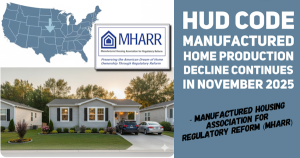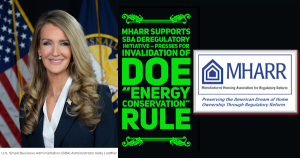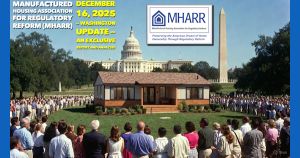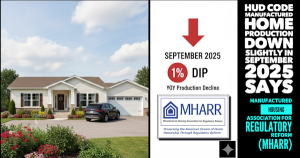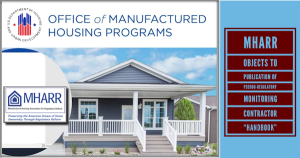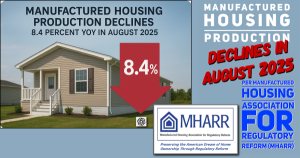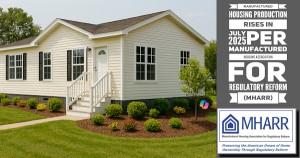MHARR Presses Case for DTS Chattel in Latest Comments and in-Person Meeting with FHFA Director
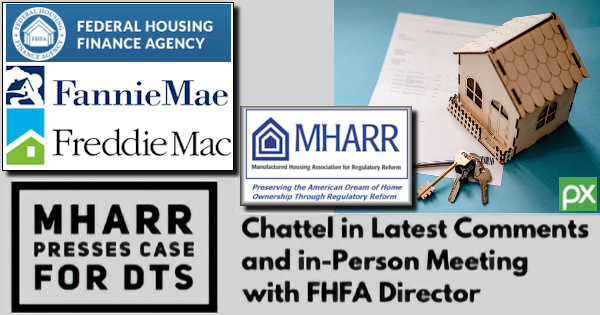
August 1, 2024
VIA FEDERAL EXPRESS
Ms. Marcea Barringer
Supervisory Policy Analyst
Attn. Duty to Serve 2025-2027 RFI
Federal Housing Finance Agency
Ninth Floor
400 Seventh Street, S.W.
Washington, D.C. 20219
Re: Request for Input — Proposed 2025-2027 Duty to Serve Plans
Dear Ms. Barringer:
The following comments are submitted on behalf of the Manufactured Housing Association for Regulatory Reform (MHARR). MHARR is a Washington, D.C.-based national trade association representing the views and interests of independent producers of manufactured housing regulated by the U.S. Department of Housing and Urban Development (HUD) pursuant to the National Manufactured Housing Construction and Safety Standards Act of 1974 as amended by the Manufactured Housing Improvement Act of 2000 (2000 Reform Law).[1] MHARR was established in 1985. Its members include manufactured housing producers located in all regions of the United States.
I. INTRODUCTION
On June 11, 2024, the Federal Housing Finance Agency (FHFA) issued a Request for Input (RFI) regarding proposed 2025-2027 Duty to Serve Underserved Markets Plans submitted for FHFA approval (i.e., non-objection) by Fannie Mae and Freddie Mac (collectively “the Enterprises”) pursuant to the statutory Duty to Serve (DTS) mandate and related FHFA implementing regulations.[2] For the reasons set forth and explained in greater detail below, the proposed plans are wholly inadequate to serve the manufactured housing market as directed by DTS, fail to comply with the full extent, scope and purpose of the DTS mandate, and continue the Enterprises’ unabated multi-decade history of flouting the DTS manufactured housing mandate to the detriment of its intended beneficiaries – lower and moderate-income consumers of affordable, mainstream manufactured housing.
Rather than serve the mainstream, affordable manufactured housing finance market as directed by Congress via DTS, both Fannie Mae and Freddie Mac have instead sought to divert DTS to a minute sub-segment of the manufactured housing market comprised of boutique, higher-cost, real estate-titled manufactured homes that are not inherently affordable for lower and moderate income consumers, are not representative of the HUD Code market as a whole, and far exceed the cost of mainstream, conventional manufactured housing. As a consequence, neither Fannie Mae or Freddie Mac have ever served the vast bulk of the mainstream manufactured housing market under DTS and, under their 2025-2027 proposed plans, will continue that total failure indefinitely. As a result, mainstream manufactured housing consumers continue to be either excluded from the HUD Code market altogether by unnecessarily high (and some would maintain quasi-“predatory”) interest rates fueled by the discriminatory absence of DTS-based securitization and secondary market support, or forced to pay unnecessarily higher rates in a less-than-fully competitive manufactured housing consumer financing market.
This ongoing failure by Fannie Mae and Freddie Mac – sanctioned, approved and abetted by FHFA as the Enterprises’ federal regulator — is in direct violation of the DTS mandate, stands in defiance of Congress’ statutory directive and is unacceptable. As a result, Congress should conduct immediate oversight of the failure of both the Enterprises and FHFA to implement DTS within the mainstream manufactured housing market and act to advance any necessary legislative enhancements to, clarifications of, and the full, market-significant implementation of the DTS manufactured housing statutory mandate.
II. COMMENTS
It has now been 16 years since Congress enacted the statutory Duty to Serve Underserved Markets mandate, directing Fannie Mae and Freddie Mac to provide securitization and secondary market support for very low, low and moderate-income families in three enumerated markets, including HUD-regulated manufactured housing. And yet, more than a decade-and-a-half later, the vast bulk of the mainstream manufactured housing consumer financing market, representing nearly 80% (or more) of all new manufactured home purchases, remains completely unserved by the Enterprises. Even worse, under the proposed 2025-2027 DTS “implementation” plans submitted by Fannie Mae and Freddie Mac, the vast bulk of the manufactured housing consumer financing market represented by personal property or “chattel” loans would remain completely unserved, in violation of both the letter and purpose of DTS.
In adopting DTS for the manufactured housing market, Congress expressly included within its scope, personal property purchase money loans for such homes,[3] in recognition of the fact that such loans have historically comprised not only the vast bulk of manufactured housing consumer loans, but also provide consumers with direct access to the industry’s most affordable mainstream homes (which is why they are predominate within the manufactured housing market). Obviously, if Congress had wished to exclude manufactured home personal property loans from DTS, it could have done so, but did not. The express inclusion of such loans, conversely, demonstrates that Congress expected and intended that manufactured housing personal property loans would be included as part of the Enterprises’ compliance with – and implementation of — the DTS mandate.
Congress’ express inclusion of manufactured home personal property loans within the scope of DTS is hardly surprising, in view of the fact that such loans – both at the time of enactment of DTS and historically – have constituted the vast bulk of all manufactured housing consumer purchase loans. Indeed, since the enactment of DTS in 2008, the proportion of manufactured homes financed and titled as personal property has actually increased. According to data compiled by the U.S. Census Bureau, the proportion of manufactured homes financed and titled as personal property in 2008, was 62%.[4] By 2014, that proportion had grown to 80% and has varied only slightly since that time, standing at 73% in 2022, the last year for which annual figures are currently available.[5] Conversely, over the same timeframe, the proportion of new manufactured homes financed and titled as real estate has rarely exceeded 20%.[6] This lopsided, nearly 80/20 proportion of manufactured homes titled and financed as personal property versus real estate, should have led the Enterprises – and FHFA as their federal regulator – to include personal property loans within any legitimate and credible implementation of DTS since its inception 16 years ago.
The Enterprises, though, despite offering lip service to the importance and prevalence of personal property loans within the mainstream manufactured housing market,[7] have yet to provide any DTS support for such loans, thereby abandoning and themselves discriminating against millions of lower and moderate-income manufactured housing consumers who already – and long have been – victims of financing discrimination, disproportionate and unnecessarily-high interest rates, government discrimination in the form of discriminatory and exclusionary zoning[8] and other unaddressed and unresolved impediments and roadblocks to affordable homeownership. Instead, then, of remedying the consumer financing aspect of these bottlenecks, as was intended by Congress, Fannie Mae and Freddie Mac are – and continue to be — part of the problem, extending and exacerbating the discrimination that chattel/personal property buyers already face, while doing virtually nothing to correct the problem and cruelly failing to fulfill Congress’ promise of DTS relief to American consumers of affordable housing.
Mainstream HUD Code manufactured homes, unlike other types of housing that are propped-up and supported by government subsidies and other taxpayer-funded initiatives, are inherently affordable. According to the latest available annual compilation of U.S. Census Bureau data (2022) the average sales price of a new, mainstream manufactured home is $127,300.[9] That amount is just 23% of the average (2022) sales price of a new site-built home including land (i.e., $540,000) and 29% of the average (2022) sales price of a site-built home without land (i.e., $430,808).[10] Yet, notwithstanding this intrinsic affordability; notwithstanding the demonstrated long-term stability of the manufactured housing consumer financing sector; and notwithstanding the demonstrated long-term ability of existing manufactured housing lenders to earn market-competitive returns at acceptable risk levels, DTS implementation within 80% or more of the manufactured housing consumer financing market represented primarily by personal property loans (but also other portions of the manufactured housing financing market), remains an illusory pipe dream.
The results of this inexcusable failure for both the industry and American consumers of affordable housing have been devastating. Since the enactment of the DTS directive in 2008, annual industry production has fallen below the historical 100,000-home benchmark in 14 of 16 years.[11] Thus, manufactured housing production has failed to meet or exceed the thirty-year consensus industry benchmark level for nearly 90% of the time that DTS has been law. Worse yet, after rising minimally above the 100,000 annual level in 2021 and 2022, production levels retreated below the 100,000 home benchmark once again in 2023, reaching only 89,169 homes, a 21% decline from total industry production in 2022.
Not surprisingly, the industry’s production collapse in 2023, representing nearly one-quarter of the entire 2022 HUD Code market, corresponded directly with a spike in interest rates on manufactured home purchase money loans, demonstrating – again — the price sensitivity of manufactured housing consumers and the extreme price elasticity of the manufactured housing market. Specifically, the Federal Reserve, as documented by multiple media reports,[12] began increasing interest rates in March 2022 and continued with rate increases through July 2023. Over that period, the Federal Funds rate increased from 0.25% to 6.5%, with consumer loan rates at even higher levels. Almost simultaneously, manufactured home production rates slowed and then turned sharply negative – and remained sharply negative for all of 2023.[13]
This strong correlation between interest rates on manufactured home consumer loans and manufactured housing production/sales levels, demonstrates the profound impact that full, market-significant implementation of the DTS mandate could have on the manufactured housing market and, conversely, the highly negative impact that its non-implementation is having.
As MHARR has demonstrated repeatedly in prior DTS comments, and as both the Enterprises and FHFA well know, the absence of securitization and secondary market support within the dominant manufactured housing personal property consumer financing market resulting from the non-implementation of DTS, means that existing portfolio lenders must retain all market risks associated with such loans. As a result, such loans are priced with higher interest rates to account, among other things, for the projected cost of that retained risk. Further, the absence of DTS-based securitization and secondary market support – and the retained risk reduction that would be provided by such support, but is not and will not be provided under the proposed 2025-2027 DTS implementation plans — keeps many lenders out of the HUD Code financing market. This de facto market exclusion diminishes overall lender participation in the mainstream manufactured housing market which, in turn, diminishes the level and degree of competition within that market and, again, promotes needlessly higher (and some argue predatory) interest rates on manufactured home consumer loans.[14]
Consequently, the policies and actions of Fannie Mae, Freddie Mac and FHFA with respect to DTS and its non-implementation for the vast bulk of the manufactured housing market and the vast bulk of mainstream manufactured housing consumers, have not only failed to lower the needlessly higher interest rates charged on consumer loans within the manufactured housing market, but has actually helped to sustain – and arguably even increase those rates – directly contrary to the intent and purposes of Congress with respect to DTS.
For over a decade after its adoption, Fannie Mae, Freddie Mac and FHFA maintained that DTS could not be implemented within the vast bulk of the manufactured housing market because of the unavailability of “information” from industry lenders concerning the performance of mainstream manufactured housing personal property loans. In the absence of such information, the Enterprises contended that such loans could not be securitized or provided secondary market support consistent with the “safety and soundness” required by other aspects of federal law. This excuse, however – if it was ever legitimate – is not legitimate or valid now. Years worth of loan performance information has reportedly been provided to the Enterprises. Moreover, the real world track record of the industry for nearly two decades again shows that manufactured housing consumer lenders have been able to function safely within that market while generating profits and providing reasonable returns for investors. Thus, it is self-evident that the Enterprises could serve the manufactured housing personal property lending sector consistent with “safety and soundness” if they wanted to.
Therein lies the problem, however, as it is evident, after nearly two decades, that the Enterprises simply do not wish to serve the vast bulk of the manufactured housing market and are using phony, feigned ignorance (among other things) as an excuse. The reality, by contrast, is that Freddie Mac had sufficient data on the manufactured housing personal property consumer financing market to produce a “due diligence and feasibility assessment” regarding support for such loans.[15] Inexplicably, however, while continuing its failure to serve the bulk of the manufactured housing consumer financing market, Freddie Mac has failed to publicly release that assessment, including its (alleged) factual inputs and/or conclusions. Fannie Mae, by contrast, does not even purport to have conducted or produced a study or assessment of its ability to provide support for the manufactured housing personal property market, simply asserting in conclusory fashion in its 2025-2027 proposed plan that chattel loan support was “considered but not included.” (Emphasis added).
There is, however, no evidence whatsoever, either in the 2024-2027 proposed plan or otherwise to establish that Fannie Mae (or Freddie Mac for that matter) has ever considered, evaluated, studied or contemplated manufactured home chattel loan support in good faith.[16] Instead, millions of Americans – and millions more with an interest in mainstream affordable manufactured housing — are instead told dismissively that they must accept the word of the Enterprises on good faith, when neither Fannie Mae or Freddie Mac have ever demonstrated one iota of good faith on the entire subject of chattel loan support.
Instead of serving the vast bulk of the mainstream manufactured housing market represented by chattel loans, both Enterprises have instead sought to divert DTS to the extremely narrow segment of the HUD Code market represented by real estate loans and, within that narrow sector, to an even more miniscule segment comprised of higher-cost “boutique” or specialty manufactured homes that are not within the mainstream of either the industry or the manufactured housing market.
For example, FHFA and the Enterprises recently touted their support – under DTS – for a new manufactured housing development in Maryland, featuring upgraded manufactured homes titled as real estate.[17] Those homes, however, based on information from the community developer’s own internet website, are priced from a low of $306,967,or 240% of the average (2022) sales price of a new mainstream manufactured home financed as personal property according to the Census Bureau data, to a high of $375,678, or nearly 300% of the average sales price of a new mainstream manufactured home financed as personal property.[18]
Consequently, instead of providing support for hundreds of thousands of mainstream manufactured home consumers under DTS, Fannie Mae and Freddie Mac are instead supporting a minor sliver of the manufactured housing market with offerings that are not inherently affordable, are much closer to the price of an “average” site-built home, according to the Census Bureau data, and have not been well-received within the market, as both Fannie Mae and Freddie Mac concede in their proposed DTS plans.[19]
Again, Fannie Mae and Freddie Mac are not providing any DTS support for the vast bulk of the mainstream manufactured housing consumer financing market and are not planning to provide any such support for yet another three years pursuant to their proposed 2025-2027 DTS plans.
Remarkably, instead of providing urgently needed, real-world DTS support for personal property manufactured housing consumer loans and the industry’s most affordable mainstream homes, Fannie Mae’s 2025-2027 proposed DTS plan includes an objective which would pursue consumer outreach and “industry engagement” to promote the “conversion of personal property MH to real estate.”[20]While again targeting only a miniscule segment of the manufactured housing market,[21] this initiative is breathtaking for its pure arrogance. Simply put, Fannie Mae, through this “objective,” effectively concedes: (1) that it has no interest in serving manufactured home personal property loans under DTS; (2) that it is biased against such loans and such borrowers; and (3) that instead of serving the broader HUD Code manufactured housing market under DTS as it actually exists, Fannie Mae wishes to use DTS as a weapon to remake that market into something that it considers more palatable (i.e., a real estate-based market). They do this not for the intended beneficiaries of DTS, but to suit themselves and their own self-serving preferences. Again, therefore, this initiative reveals an underlying intent on the part of the Enterprises to undermine, subvert and divert DTS support within the manufactured housing market, away from mainstream manufactured housing and mainstream manufactured housing consumers and to the unrelated aims and prejudices of both Fannie Mae and Freddie Mac.
III. CONCLUSION
Based on the foregoing (and incorporating by reference herein its prior DTS comments), MHARR strongly opposes the approval of the proposed 2025-2027 DTS Implementation Plans in their current form.
Far from implementing DTS within the overwhelming bulk of the statutory manufactured housing market, those plans, as submitted, would continue the Enterprises’ longstanding defiance of the DTS mandate and Congress’ directive to begin serving the manufactured housing market and millions of manufactured housing consumers on a non-discriminatory basis. Rather than benefiting manufactured housing consumers by expanding the availability of competitively-priced manufactured home loans and engendering increased competition within the manufactured housing consumer financing market, the Enterprises’ defiance of DTS has materially harmed American consumers by supporting and sustaining needlessly high purchase loan interest rates within the HUD Code market. This failure is inexcusable and based on the 2025-2027 proposed plans, represents continuing defiance of both Congress and the DTS mandate with no end in sight, as the proposed plans would extend the non-implementation of DTS within the vast bulk of the mainstream manufactured housing market indefinitely with no valid, sufficient or legitimate reason, explanation or even excuse.
As a result, MHARR will strongly urge Congress to engage in meaningful oversight with respect to DTS and its non-implementation by the Enterprises within the manufactured housing market, and will seek necessary reforms to ensure that the Enterprises and FHFA are no longer able to subvert, distort and/or ignore DTS to the extreme detriment of the manufactured housing market and American consumers of affordable housing.
Sincerely
Mark Weiss
President and CEO
cc: Hon. Sandra Thompson
Hon. Adrianne Todman
Hon. Sherrod Brown
Hon. Tim Scott
Hon. Patrick McHenry
Hon. Maxine Waters
Other Interested HUD Code Manufactured Housing Industry Members
[1] See, 42 U.S.C. 5401, et seq.
[2] See, 12 U.S.C. 4565; 12 C.F.R. 1282.32.
[3] See, 12 U.S.C. 4565(d)(3): “In determining whether an enterprise has complied with the duty under subparagraph (A) of subsection (a)(1), the Director may consider loans secured by both real and personal property.” (Emphasis added). This clause reflects an unambiguous expectation on the part of Congress that manufactured housing personal property loans – which predominate within the mainstream manufactured housing consumer financing market — would be included as part of the Enterprises’ implementation of DTS. Even if this clause were to be deemed “ambiguous,” however, any claim by FHFA or the Enterprises that the “duty” mandated by DTS with respect to manufactured housing personal property loans is somehow “permissive,” would no longer receive any type of deference or deferential consideration by a reviewing court. See, Loper Bright Enterprises v. Raimondo, 603 U.S. ___ (2024).
[4] See, Attachment 1, hereto, U.S. Census Bureau, Size and Cost Comparison: New Manufactured Homes and New Single-Family Site Built Homes (2007-2014) and (2014-2022).
[5] Id.
[6] Id.
[7] See, Fannie Mae 2025-2027 Duty to Serve Underserved Markets Proposed Implementation Plan at p. MH-39.
[8] Freddie Mac’s proposed DTS Plan, in fact, recognizes and acknowledges the impact of zoning discrimination on manufactured housing and manufactured housing residents, yet does nothing to counteract that discrimination. See, Freddie Mac 2025-2027 Duty to Serve Underserved Markets Proposed Implementation Plan at p. MH-22.
[9] See, Attachment 1, supra.
[10] Id. It should be noted that Census Bureau monthly data for 2023 shows that the average sales price of a new HUD Code manufactured home fell to $124,133, or a further reduction of 2.5% from the 2022 annual price level.
[11] See, Attachment 2, hereto, HUD-compiled manufactured housing production statistics for the period 2008-2023.
[12] See, e.g., The Street, “A Timeline of the Fed’s ’22-’23 Rate Hikes and What Caused Them,” (April 12, 2024).
[13] Freddie Mac’s 2025-2027 Duty to Serve Underserved Markets Proposed Implementation Plan fully acknowledges this correlation, but fails to connect the interest rate spike in the manufactured housing market – and its dire consequences – with its own failure (and that of Fannie Mae) to implement DTS, at all, within the broadest segment of the manufactured housing market, stating: “Interest rates rose rapidly starting in 2022, more than doubling from 3.8% in second quarter 2022 to 7.79% in fourth quarter 2023. They have receded slightly since then but remained near 7% at the end of first quarter 2024. During those years … manufactured housing supply and production remained tight…. Loan originations and Freddie Mac’s loan purchases significantly contracted as a result….” Id. at p. MH-20.
[14] See, e.g., MHARR July 15, 2021 written comments, “Request for Input: Fannie Mae and Freddie Mac Proposed 2022-2024 Duty to Serve Plans” at pp.3-5.
[15] See, Freddie Mac 2025-2027 Duty to Serve Underserved Markets Proposed Implementation Plan at p. MH-14
[16] Indeed, all promises of future chattel loan programs in the out-years of previous DTS implementation plans have turned out to be empty window dressing, having never been implemented.
[17] Both Fannie and Freddie describe these so-called “Cross-Mod” homes as having “the features and aesthetics of a site-built home.” See, e.g., Freddie Mac 2025-2027 Duty to Serve Underserved Markets Proposed Implementation Plan at p. MH-11.
[18] With the reduction in the average price of mainstream manufactured homes indicated by the 2023 monthly census bureau statistics, these percentages become even more stark, with the lowest-cost Maryland home exceeding the average price of a new mainstream HUD Code home by 247% and the highest cost Maryland home exceeding the mainstream average by nearly 303%.
[19] See, e.g., Fannie Mae 2025-2027 Duty to Serve Underserved Markets Proposed Implementation Plan at p. MH-41: “Much of Fannie Mae’s prior efforts in the MH market have focused on attempting to impact the supply of new manufactured homes, oftentimes through large scale marketing and industry engagement efforts related to our MH Advantage loan product. …[T]hese efforts have produced modest results….” (Emphasis added).
[20] See, Fannie Mae 2025-2027 Duty to Serve Underserved Markets Proposed Implementation Plan at pp. MH-49-50.
[21] Id. at p. MH-49, noting that this initiative targets “roughly 17% of all landowning [MH] borrowers.” Again, therefore, rather than serving the vast bulk of the mainstream manufactured housing market, this misdirected and insulting effort targets a small subset of an already miniscule pool of landowning chattel borrowers.
August 1, 2024
VIA FEDERAL EXPRESS
Ms. Marcea Barringer
Supervisory Policy Analyst
Attn. Duty to Serve 2025-2027 RFI
Federal Housing Finance Agency
Ninth Floor
400 Seventh Street, S.W.
Washington, D.C. 20219
Re: Request for Input — Proposed 2025-2027 Duty to Serve Plans
Dear Ms. Barringer:
The following comments are submitted on behalf of the Manufactured Housing Association for Regulatory Reform (MHARR). MHARR is a Washington, D.C.-based national trade association representing the views and interests of independent producers of manufactured housing regulated by the U.S. Department of Housing and Urban Development (HUD) pursuant to the National Manufactured Housing Construction and Safety Standards Act of 1974 as amended by the Manufactured Housing Improvement Act of 2000 (2000 Reform Law).[1] MHARR was established in 1985. Its members include manufactured housing producers located in all regions of the United States.
I. INTRODUCTION
On June 11, 2024, the Federal Housing Finance Agency (FHFA) issued a Request for Input (RFI) regarding proposed 2025-2027 Duty to Serve Underserved Markets Plans submitted for FHFA approval (i.e., non-objection) by Fannie Mae and Freddie Mac (collectively “the Enterprises”) pursuant to the statutory Duty to Serve (DTS) mandate and related FHFA implementing regulations.[2] For the reasons set forth and explained in greater detail below, the proposed plans are wholly inadequate to serve the manufactured housing market as directed by DTS, fail to comply with the full extent, scope and purpose of the DTS mandate, and continue the Enterprises’ unabated multi-decade history of flouting the DTS manufactured housing mandate to the detriment of its intended beneficiaries – lower and moderate-income consumers of affordable, mainstream manufactured housing.
Rather than serve the mainstream, affordable manufactured housing finance market as directed by Congress via DTS, both Fannie Mae and Freddie Mac have instead sought to divert DTS to a minute sub-segment of the manufactured housing market comprised of boutique, higher-cost, real estate-titled manufactured homes that are not inherently affordable for lower and moderate income consumers, are not representative of the HUD Code market as a whole, and far exceed the cost of mainstream, conventional manufactured housing. As a consequence, neither Fannie Mae or Freddie Mac have ever served the vast bulk of the mainstream manufactured housing market under DTS and, under their 2025-2027 proposed plans, will continue that total failure indefinitely. As a result, mainstream manufactured housing consumers continue to be either excluded from the HUD Code market altogether by unnecessarily high (and some would maintain quasi-“predatory”) interest rates fueled by the discriminatory absence of DTS-based securitization and secondary market support, or forced to pay unnecessarily higher rates in a less-than-fully competitive manufactured housing consumer financing market.
This ongoing failure by Fannie Mae and Freddie Mac – sanctioned, approved and abetted by FHFA as the Enterprises’ federal regulator — is in direct violation of the DTS mandate, stands in defiance of Congress’ statutory directive and is unacceptable. As a result, Congress should conduct immediate oversight of the failure of both the Enterprises and FHFA to implement DTS within the mainstream manufactured housing market and act to advance any necessary legislative enhancements to, clarifications of, and the full, market-significant implementation of the DTS manufactured housing statutory mandate.
II. COMMENTS
It has now been 16 years since Congress enacted the statutory Duty to Serve Underserved Markets mandate, directing Fannie Mae and Freddie Mac to provide securitization and secondary market support for very low, low and moderate-income families in three enumerated markets, including HUD-regulated manufactured housing. And yet, more than a decade-and-a-half later, the vast bulk of the mainstream manufactured housing consumer financing market, representing nearly 80% (or more) of all new manufactured home purchases, remains completely unserved by the Enterprises. Even worse, under the proposed 2025-2027 DTS “implementation” plans submitted by Fannie Mae and Freddie Mac, the vast bulk of the manufactured housing consumer financing market represented by personal property or “chattel” loans would remain completely unserved, in violation of both the letter and purpose of DTS.
In adopting DTS for the manufactured housing market, Congress expressly included within its scope, personal property purchase money loans for such homes,[3] in recognition of the fact that such loans have historically comprised not only the vast bulk of manufactured housing consumer loans, but also provide consumers with direct access to the industry’s most affordable mainstream homes (which is why they are predominate within the manufactured housing market). Obviously, if Congress had wished to exclude manufactured home personal property loans from DTS, it could have done so, but did not. The express inclusion of such loans, conversely, demonstrates that Congress expected and intended that manufactured housing personal property loans would be included as part of the Enterprises’ compliance with – and implementation of — the DTS mandate.
Congress’ express inclusion of manufactured home personal property loans within the scope of DTS is hardly surprising, in view of the fact that such loans – both at the time of enactment of DTS and historically – have constituted the vast bulk of all manufactured housing consumer purchase loans. Indeed, since the enactment of DTS in 2008, the proportion of manufactured homes financed and titled as personal property has actually increased. According to data compiled by the U.S. Census Bureau, the proportion of manufactured homes financed and titled as personal property in 2008, was 62%.[4] By 2014, that proportion had grown to 80% and has varied only slightly since that time, standing at 73% in 2022, the last year for which annual figures are currently available.[5] Conversely, over the same timeframe, the proportion of new manufactured homes financed and titled as real estate has rarely exceeded 20%.[6] This lopsided, nearly 80/20 proportion of manufactured homes titled and financed as personal property versus real estate, should have led the Enterprises – and FHFA as their federal regulator – to include personal property loans within any legitimate and credible implementation of DTS since its inception 16 years ago.
The Enterprises, though, despite offering lip service to the importance and prevalence of personal property loans within the mainstream manufactured housing market,[7] have yet to provide any DTS support for such loans, thereby abandoning and themselves discriminating against millions of lower and moderate-income manufactured housing consumers who already – and long have been – victims of financing discrimination, disproportionate and unnecessarily-high interest rates, government discrimination in the form of discriminatory and exclusionary zoning[8] and other unaddressed and unresolved impediments and roadblocks to affordable homeownership. Instead, then, of remedying the consumer financing aspect of these bottlenecks, as was intended by Congress, Fannie Mae and Freddie Mac are – and continue to be — part of the problem, extending and exacerbating the discrimination that chattel/personal property buyers already face, while doing virtually nothing to correct the problem and cruelly failing to fulfill Congress’ promise of DTS relief to American consumers of affordable housing.
Mainstream HUD Code manufactured homes, unlike other types of housing that are propped-up and supported by government subsidies and other taxpayer-funded initiatives, are inherently affordable. According to the latest available annual compilation of U.S. Census Bureau data (2022) the average sales price of a new, mainstream manufactured home is $127,300.[9] That amount is just 23% of the average (2022) sales price of a new site-built home including land (i.e., $540,000) and 29% of the average (2022) sales price of a site-built home without land (i.e., $430,808).[10] Yet, notwithstanding this intrinsic affordability; notwithstanding the demonstrated long-term stability of the manufactured housing consumer financing sector; and notwithstanding the demonstrated long-term ability of existing manufactured housing lenders to earn market-competitive returns at acceptable risk levels, DTS implementation within 80% or more of the manufactured housing consumer financing market represented primarily by personal property loans (but also other portions of the manufactured housing financing market), remains an illusory pipe dream.
The results of this inexcusable failure for both the industry and American consumers of affordable housing have been devastating. Since the enactment of the DTS directive in 2008, annual industry production has fallen below the historical 100,000-home benchmark in 14 of 16 years.[11] Thus, manufactured housing production has failed to meet or exceed the thirty-year consensus industry benchmark level for nearly 90% of the time that DTS has been law. Worse yet, after rising minimally above the 100,000 annual level in 2021 and 2022, production levels retreated below the 100,000 home benchmark once again in 2023, reaching only 89,169 homes, a 21% decline from total industry production in 2022.
Not surprisingly, the industry’s production collapse in 2023, representing nearly one-quarter of the entire 2022 HUD Code market, corresponded directly with a spike in interest rates on manufactured home purchase money loans, demonstrating – again — the price sensitivity of manufactured housing consumers and the extreme price elasticity of the manufactured housing market. Specifically, the Federal Reserve, as documented by multiple media reports,[12] began increasing interest rates in March 2022 and continued with rate increases through July 2023. Over that period, the Federal Funds rate increased from 0.25% to 6.5%, with consumer loan rates at even higher levels. Almost simultaneously, manufactured home production rates slowed and then turned sharply negative – and remained sharply negative for all of 2023.[13]
This strong correlation between interest rates on manufactured home consumer loans and manufactured housing production/sales levels, demonstrates the profound impact that full, market-significant implementation of the DTS mandate could have on the manufactured housing market and, conversely, the highly negative impact that its non-implementation is having.
As MHARR has demonstrated repeatedly in prior DTS comments, and as both the Enterprises and FHFA well know, the absence of securitization and secondary market support within the dominant manufactured housing personal property consumer financing market resulting from the non-implementation of DTS, means that existing portfolio lenders must retain all market risks associated with such loans. As a result, such loans are priced with higher interest rates to account, among other things, for the projected cost of that retained risk. Further, the absence of DTS-based securitization and secondary market support – and the retained risk reduction that would be provided by such support, but is not and will not be provided under the proposed 2025-2027 DTS implementation plans — keeps many lenders out of the HUD Code financing market. This de facto market exclusion diminishes overall lender participation in the mainstream manufactured housing market which, in turn, diminishes the level and degree of competition within that market and, again, promotes needlessly higher (and some argue predatory) interest rates on manufactured home consumer loans.[14]
Consequently, the policies and actions of Fannie Mae, Freddie Mac and FHFA with respect to DTS and its non-implementation for the vast bulk of the manufactured housing market and the vast bulk of mainstream manufactured housing consumers, have not only failed to lower the needlessly higher interest rates charged on consumer loans within the manufactured housing market, but has actually helped to sustain – and arguably even increase those rates – directly contrary to the intent and purposes of Congress with respect to DTS.
For over a decade after its adoption, Fannie Mae, Freddie Mac and FHFA maintained that DTS could not be implemented within the vast bulk of the manufactured housing market because of the unavailability of “information” from industry lenders concerning the performance of mainstream manufactured housing personal property loans. In the absence of such information, the Enterprises contended that such loans could not be securitized or provided secondary market support consistent with the “safety and soundness” required by other aspects of federal law. This excuse, however – if it was ever legitimate – is not legitimate or valid now. Years worth of loan performance information has reportedly been provided to the Enterprises. Moreover, the real world track record of the industry for nearly two decades again shows that manufactured housing consumer lenders have been able to function safely within that market while generating profits and providing reasonable returns for investors. Thus, it is self-evident that the Enterprises could serve the manufactured housing personal property lending sector consistent with “safety and soundness” if they wanted to.
Therein lies the problem, however, as it is evident, after nearly two decades, that the Enterprises simply do not wish to serve the vast bulk of the manufactured housing market and are using phony, feigned ignorance (among other things) as an excuse. The reality, by contrast, is that Freddie Mac had sufficient data on the manufactured housing personal property consumer financing market to produce a “due diligence and feasibility assessment” regarding support for such loans.[15] Inexplicably, however, while continuing its failure to serve the bulk of the manufactured housing consumer financing market, Freddie Mac has failed to publicly release that assessment, including its (alleged) factual inputs and/or conclusions. Fannie Mae, by contrast, does not even purport to have conducted or produced a study or assessment of its ability to provide support for the manufactured housing personal property market, simply asserting in conclusory fashion in its 2025-2027 proposed plan that chattel loan support was “considered but not included.” (Emphasis added).
There is, however, no evidence whatsoever, either in the 2024-2027 proposed plan or otherwise to establish that Fannie Mae (or Freddie Mac for that matter) has ever considered, evaluated, studied or contemplated manufactured home chattel loan support in good faith.[16] Instead, millions of Americans – and millions more with an interest in mainstream affordable manufactured housing — are instead told dismissively that they must accept the word of the Enterprises on good faith, when neither Fannie Mae or Freddie Mac have ever demonstrated one iota of good faith on the entire subject of chattel loan support.
Instead of serving the vast bulk of the mainstream manufactured housing market represented by chattel loans, both Enterprises have instead sought to divert DTS to the extremely narrow segment of the HUD Code market represented by real estate loans and, within that narrow sector, to an even more miniscule segment comprised of higher-cost “boutique” or specialty manufactured homes that are not within the mainstream of either the industry or the manufactured housing market.
For example, FHFA and the Enterprises recently touted their support – under DTS – for a new manufactured housing development in Maryland, featuring upgraded manufactured homes titled as real estate.[17] Those homes, however, based on information from the community developer’s own internet website, are priced from a low of $306,967,or 240% of the average (2022) sales price of a new mainstream manufactured home financed as personal property according to the Census Bureau data, to a high of $375,678, or nearly 300% of the average sales price of a new mainstream manufactured home financed as personal property.[18]
Consequently, instead of providing support for hundreds of thousands of mainstream manufactured home consumers under DTS, Fannie Mae and Freddie Mac are instead supporting a minor sliver of the manufactured housing market with offerings that are not inherently affordable, are much closer to the price of an “average” site-built home, according to the Census Bureau data, and have not been well-received within the market, as both Fannie Mae and Freddie Mac concede in their proposed DTS plans.[19]
Again, Fannie Mae and Freddie Mac are not providing any DTS support for the vast bulk of the mainstream manufactured housing consumer financing market and are not planning to provide any such support for yet another three years pursuant to their proposed 2025-2027 DTS plans.
Remarkably, instead of providing urgently needed, real-world DTS support for personal property manufactured housing consumer loans and the industry’s most affordable mainstream homes, Fannie Mae’s 2025-2027 proposed DTS plan includes an objective which would pursue consumer outreach and “industry engagement” to promote the “conversion of personal property MH to real estate.”[20]While again targeting only a miniscule segment of the manufactured housing market,[21] this initiative is breathtaking for its pure arrogance. Simply put, Fannie Mae, through this “objective,” effectively concedes: (1) that it has no interest in serving manufactured home personal property loans under DTS; (2) that it is biased against such loans and such borrowers; and (3) that instead of serving the broader HUD Code manufactured housing market under DTS as it actually exists, Fannie Mae wishes to use DTS as a weapon to remake that market into something that it considers more palatable (i.e., a real estate-based market). They do this not for the intended beneficiaries of DTS, but to suit themselves and their own self-serving preferences. Again, therefore, this initiative reveals an underlying intent on the part of the Enterprises to undermine, subvert and divert DTS support within the manufactured housing market, away from mainstream manufactured housing and mainstream manufactured housing consumers and to the unrelated aims and prejudices of both Fannie Mae and Freddie Mac.
III. CONCLUSION
Based on the foregoing (and incorporating by reference herein its prior DTS comments), MHARR strongly opposes the approval of the proposed 2025-2027 DTS Implementation Plans in their current form.
Far from implementing DTS within the overwhelming bulk of the statutory manufactured housing market, those plans, as submitted, would continue the Enterprises’ longstanding defiance of the DTS mandate and Congress’ directive to begin serving the manufactured housing market and millions of manufactured housing consumers on a non-discriminatory basis. Rather than benefiting manufactured housing consumers by expanding the availability of competitively-priced manufactured home loans and engendering increased competition within the manufactured housing consumer financing market, the Enterprises’ defiance of DTS has materially harmed American consumers by supporting and sustaining needlessly high purchase loan interest rates within the HUD Code market. This failure is inexcusable and based on the 2025-2027 proposed plans, represents continuing defiance of both Congress and the DTS mandate with no end in sight, as the proposed plans would extend the non-implementation of DTS within the vast bulk of the mainstream manufactured housing market indefinitely with no valid, sufficient or legitimate reason, explanation or even excuse.
As a result, MHARR will strongly urge Congress to engage in meaningful oversight with respect to DTS and its non-implementation by the Enterprises within the manufactured housing market, and will seek necessary reforms to ensure that the Enterprises and FHFA are no longer able to subvert, distort and/or ignore DTS to the extreme detriment of the manufactured housing market and American consumers of affordable housing.
Sincerely
Mark Weiss
President and CEO
cc: Hon. Sandra Thompson
Hon. Adrianne Todman
Hon. Sherrod Brown
Hon. Tim Scott
Hon. Patrick McHenry
Hon. Maxine Waters
Other Interested HUD Code Manufactured Housing Industry Members
[1] See, 42 U.S.C. 5401, et seq.
[2] See, 12 U.S.C. 4565; 12 C.F.R. 1282.32.
[3] See, 12 U.S.C. 4565(d)(3): “In determining whether an enterprise has complied with the duty under subparagraph (A) of subsection (a)(1), the Director may consider loans secured by both real and personal property.” (Emphasis added). This clause reflects an unambiguous expectation on the part of Congress that manufactured housing personal property loans – which predominate within the mainstream manufactured housing consumer financing market — would be included as part of the Enterprises’ implementation of DTS. Even if this clause were to be deemed “ambiguous,” however, any claim by FHFA or the Enterprises that the “duty” mandated by DTS with respect to manufactured housing personal property loans is somehow “permissive,” would no longer receive any type of deference or deferential consideration by a reviewing court. See, Loper Bright Enterprises v. Raimondo, 603 U.S. ___ (2024).
[4] See, Attachment 1, hereto, U.S. Census Bureau, Size and Cost Comparison: New Manufactured Homes and New Single-Family Site Built Homes (2007-2014) and (2014-2022).
[5] Id.
[6] Id.
[7] See, Fannie Mae 2025-2027 Duty to Serve Underserved Markets Proposed Implementation Plan at p. MH-39.
[8] Freddie Mac’s proposed DTS Plan, in fact, recognizes and acknowledges the impact of zoning discrimination on manufactured housing and manufactured housing residents, yet does nothing to counteract that discrimination. See, Freddie Mac 2025-2027 Duty to Serve Underserved Markets Proposed Implementation Plan at p. MH-22.
[9] See, Attachment 1, supra.
[10] Id. It should be noted that Census Bureau monthly data for 2023 shows that the average sales price of a new HUD Code manufactured home fell to $124,133, or a further reduction of 2.5% from the 2022 annual price level.
[11] See, Attachment 2, hereto, HUD-compiled manufactured housing production statistics for the period 2008-2023.
[12] See, e.g., The Street, “A Timeline of the Fed’s ’22-’23 Rate Hikes and What Caused Them,” (April 12, 2024).
[13] Freddie Mac’s 2025-2027 Duty to Serve Underserved Markets Proposed Implementation Plan fully acknowledges this correlation, but fails to connect the interest rate spike in the manufactured housing market – and its dire consequences – with its own failure (and that of Fannie Mae) to implement DTS, at all, within the broadest segment of the manufactured housing market, stating: “Interest rates rose rapidly starting in 2022, more than doubling from 3.8% in second quarter 2022 to 7.79% in fourth quarter 2023. They have receded slightly since then but remained near 7% at the end of first quarter 2024. During those years … manufactured housing supply and production remained tight…. Loan originations and Freddie Mac’s loan purchases significantly contracted as a result….” Id. at p. MH-20.
[14] See, e.g., MHARR July 15, 2021 written comments, “Request for Input: Fannie Mae and Freddie Mac Proposed 2022-2024 Duty to Serve Plans” at pp.3-5.
[15] See, Freddie Mac 2025-2027 Duty to Serve Underserved Markets Proposed Implementation Plan at p. MH-14
[16] Indeed, all promises of future chattel loan programs in the out-years of previous DTS implementation plans have turned out to be empty window dressing, having never been implemented.
[17] Both Fannie and Freddie describe these so-called “Cross-Mod” homes as having “the features and aesthetics of a site-built home.” See, e.g., Freddie Mac 2025-2027 Duty to Serve Underserved Markets Proposed Implementation Plan at p. MH-11.
[18] With the reduction in the average price of mainstream manufactured homes indicated by the 2023 monthly census bureau statistics, these percentages become even more stark, with the lowest-cost Maryland home exceeding the average price of a new mainstream HUD Code home by 247% and the highest cost Maryland home exceeding the mainstream average by nearly 303%.
[19] See, e.g., Fannie Mae 2025-2027 Duty to Serve Underserved Markets Proposed Implementation Plan at p. MH-41: “Much of Fannie Mae’s prior efforts in the MH market have focused on attempting to impact the supply of new manufactured homes, oftentimes through large scale marketing and industry engagement efforts related to our MH Advantage loan product. …[T]hese efforts have produced modest results….” (Emphasis added).
[20] See, Fannie Mae 2025-2027 Duty to Serve Underserved Markets Proposed Implementation Plan at pp. MH-49-50.
[21] Id. at p. MH-49, noting that this initiative targets “roughly 17% of all landowning [MH] borrowers.” Again, therefore, rather than serving the vast bulk of the mainstream manufactured housing market, this misdirected and insulting effort targets a small subset of an already miniscule pool of landowning chattel borrowers.

